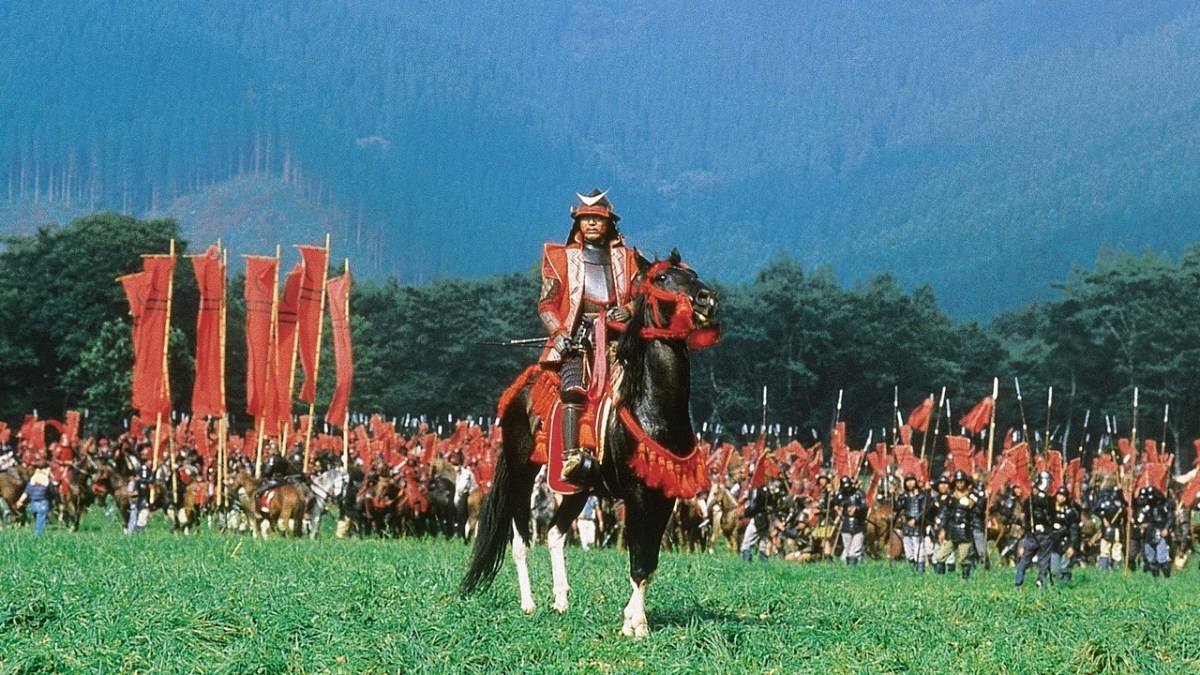Among the masterpieces of Kurosawa, this one sits confidently at the very, very top, and is quite rightly one of the greatest films ever made of all-time.

Review #881
Dir. Akira Kurosawa
1985 | Japan | Drama/War | 160 mins | 1.85:1 | Japanese
PG13 (passed clean) for battle sequences
Cast: Tatsuya Nakadai, Akira Terao, Jinpachi Nezu
Plot: In Medieval Japan, an elderly warlord retires, handing over his empire to his three sons. However, he vastly underestimates how the new-found power will corrupt them and cause them to turn on each other…and him.
Awards: Won 1 Oscar – Best Costume Design. Nom. for 3 Oscars – Best Director, Best Cinematography, Best Art Direction-Set Decoration.
Source: Studiocanal
Accessibility Index
Subject Matter: Moderate – Power, Greed
Narrative Style: Complex
Pace: Slightly Slow
Audience Type: Slightly Arthouse
Viewed: Blu-ray
First Published: 16 Apr 2013
Spoilers: No
I had a hard time deciding which was my favourite Kurosawa film for a long time – Ran or Seven Samurai (1954). Both are incredible films, but if you put a gun to my head, I might pick Seven Samurai. But this review is about Ran.
I have rewatched it more than five times now, the latest occasion on Blu-ray. Nothing has changed my admiration for the film. I still feel it is one of the best films I have seen of all-time.
What struck me most was Kurosawa’s direction of his actors and the battle scenes. Tatsuya Nakadai who plays Lord Hidetora gives one of the great performances that befits a person who has gone insane and has lost himself in a world of chaos, betrayal and irrational violence.
“In a mad world, only the mad are sane,” says Kyoami, a clownish character who provides comic relief and levity in a serious film based loosely on Shakespeare’s ‘King Lear’.
The drama focuses on an elderly Hidetora who gives up his absolute power to his eldest son, while splitting the remaining conquered land to his two younger sons.
“Man is born crying. When he has cried enough, he dies.”
What transpires is an epic disintegration of the father-son bond, ruled by the desire for authority, jealously, vengeance and a host of other debilitating factors. Kurosawa paints a picture of distinct colours.
Blood spilled is an unnatural bright red; the different coloured flags of opposing armies sway in the wind as they wait for the battle cry.
The cinematography is absolutely breathtaking – reverse shots could be a hundred miles away, and the attention to detail and realism is extraordinary. There is a scene where Hidetora walks out of a burning castle – that is an actual fire raging with huge clouds of smoke billowing.
Kurosawa’s staging of action or the prospect of action is unparalleled. One of my favourite scenes is that of an army of men on horses paddling across a river from one bank to another, accompanied by the deep thumping of an orchestral drum. The music by Toru Takemitsu is never intrusive, providing a haunting aural backdrop to a bleak world.
Winning an Oscar for Best Costume Design, Ran failed to land a nomination for Best Foreign Language Film, despite being nominated additionally for Best Director, Cinematography and Art Direction.
This was Kurosawa’s last great film, made when he was 75 years of age. It was as if he needed a lifetime of wisdom to deliver the film.
Grade: A+
Trailer:
Music:












Ran is definitely a great film. Thanks for reviewing it. I really enjoyed that movie when I saw it years ago. Another good adaptation of a Shakespeare work from Kurosawa would be Throne of Blood.
LikeLiked by 2 people
I really love Throne of Blood, also 5 stars for me. Every time I see it, it gets better and better!
LikeLiked by 2 people
Nice! That’s another one I should watch again and possibly review in the future.
LikeLiked by 2 people
[…] for his magnum opus, Mulholland Drive (2001), much like Kurosawa’s Kagemusha (1980) to his Ran (1985) if one were to put it that […]
LikeLike
[…] see references to Kurosawa (Ran and Throne of Blood in particular), Gojira, Mizoguchi, Ozu, and more, and also how Japanese cinema […]
LikeLike
[…] despite having scenes of chaos and violence, in particular a sequence inspired by Kurosawa’s Ran (1985) where penetrating arrows from all directions fail to strike a calm and collected old master. […]
LikeLike
[…] the only time—that Miyazaki has channelled the spirit of Kurosawa, with visual influences from Ran (1985) […]
LikeLike